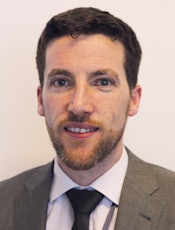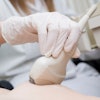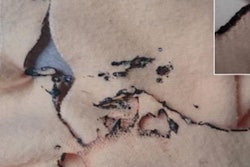
VIENNA - Radiology departments have a moral, professional, and legal responsibility to protect the safety of patients receiving imaging studies with ionizing radiation. It takes teamwork, however, to meet that critical mandate, according to a talk at ECR 2017.
 Shane Foley, PhD. Image courtesy of Christof. G. Pelz I GRAFIFANT Creation. Grafik. Photo I www.grafifant.at.
Shane Foley, PhD. Image courtesy of Christof. G. Pelz I GRAFIFANT Creation. Grafik. Photo I www.grafifant.at.Radiologists, radiographers, medical physicists, and others need to collaborate to truly foster a culture that protects patient safety, said Shane Foley, PhD, a radiographer and an assistant professor and lecturer at University College Dublin School of Medicine in Ireland.
"Every person, every different profession within the radiology department has a part to play in this aspect," Foley said. "It's not just down to one individual or one responsible person."
Foley previewed his upcoming Saturday morning talk during ECR 2017's opening press conference on Wednesday.
Patient risks
Patients can encounter a number of potential risks from their visit to the radiology department, including a missed abnormality due to technical issues as well as perception and communication errors, Foley said. Other potential errors caused by human mistakes include the wrong procedure being performed or studies being performed on the wrong patient or the wrong side of the patient. Importantly, radiation exposure also has risk, including the potential for stochastic effects and tissue reactions.
"All of these risks should be obvious to everyone in radiology, and we should all take personal responsibility as well," he said. "No matter whether you're a radiologist, radiographer, physicist, or anyone in the healthcare environment, we always have to be conscious that our practice inherently has risks."
An institution might not be aware of any potential safety issues, but that doesn't mean they're not taking place, Foley said.
"Oftentimes that means [patient safety issues] are just hidden, and we need to bring patient safety to the front of our agenda so that we're always conscious of it," he said.
Individual responsibility
While patient safety must be given high priority and actively addressed at an organizational level, all individuals in the department -- no matter the profession -- must take responsibility for being accountable for patient safety. In addition, everyone should be encouraged to voice any safety concerns they might have, Foley said.
"They should be empowered to speak up ... so we can obviously prevent a safety issue from occurring," he said.
Organizations have the obligation to establish and regularly review standards, Foley said. Deviations from these standards should be recognized.
Where possible, defensive strategies should be employed to reduce the number of safety issues and, ideally, prevent them from happening in the first place, he said.
"Collectively, we all need to learn from problems and then change accordingly," Foley said.
A legal responsibility
On a moral and professional level, radiology departments have the responsibility to provide radiation protection for patients, including justification, optimization, and limiting dose, Foley said. There is also a legal requirement: In late 2013, the European Union revised its Basic Safety Standards (BSS) via Directive 2013/59/Euratom. The regulation details standards for protecting patients against the dangers from exposure to ionizing radiation, and EU member states must comply with the standards by February 6, 2018.
Foley said the No. 1 pillar of patient safety is justification -- i.e., making sure every imaging examination performed carries more benefit than risk to patients.
"Simply by abiding by this, we can really improve the safety of our patients from a radiation perspective," he said.
The new European regulations bring enhanced requirements, such as justifying every individual exposure in advance of the exam. Radiographers can also play a critical role in this process.
"Oftentimes the radiographer might be the only one to meet with a patient as they come to a hospital setting," Foley said. "It's important at that point of contact to be able to gather more information, converse with the patients, and learn new information that may be able to either change the examination that might be done, or perhaps decide a different examination is needed or no examination is needed. That's why we need to work together as a team within radiology; [we must] consult, cooperate, and collaborate to ensure that our patients only get those tests that they need and that they get the best tests."
In terms of optimization, the European directive also adds obligations for radiologists, medical physicists, and radiographers. The directive will help improve patient safety culture, placing more obligations on more people across a wider range of diagnostic studies, Foley said. There are also a few new roles, such as designating a patient safety officer, and additional education and training requirements.
Benefits of collaboration
Foley noted that legal responsibilities are just one part of the patient safety puzzle, and they only reinforce moral and professional duties in caring for patients. Radiologists, medical physicists, radiographers, and everyone in radiology has an important part to play in ensuring patient safety, he said.
Indeed, the benefits of this collaboration have already been demonstrated in a variety of European projects, such as the European Commission's Medical Radiation Protection Education and Training (MEDRAPET) initiative, the EuroSafe Imaging campaign, the European Alliance for Medical Radiation Protection Research (EURAMED), the European Medical ALARA Network (EMAN), and the European Diagnostic Reference Levels for Pediatric Imaging (PiDRL) project.
"We all have shared values, and it's important that our shared behaviors are propagated so that we improve standards and hopefully ensure that we do have a patient safety culture going forward," he said.
ECR 2017 President Dr. Paul Parizel, PhD, agreed with the importance of focusing on patients.
"Radiology is about patients; it's not about images," he said. "We actually ... take care of patients -- we diagnose patients and we treat patients with image-guided techniques. But it's about patients."



















